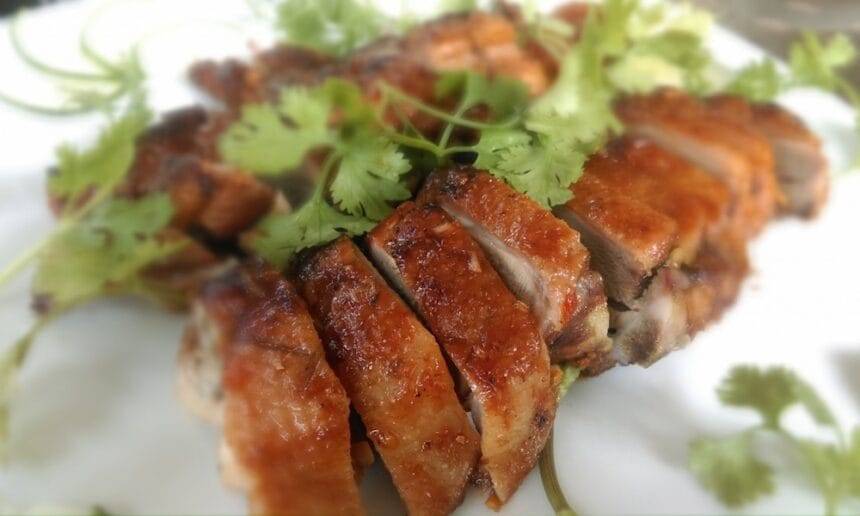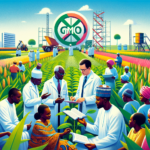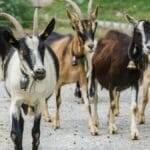Main Points In Hindi (मुख्य बातें – हिंदी में)
-
चीन में मांस के प्रकार में बदलाव: 1.4 अरब लोगों के देश चीन में शुद्ध पौष्टिकता की ओर बढ़ते हुए, लोग सूअर का मांस छोड़कर गोमांस और मुर्गी पालन की ओर बढ़ रहे हैं। इसके पीछे स्वास्थ्य और गुणवत्ता की चिंताएं हैं।
-
आर्थिक प्रभाव: चीन की बढ़ती समृद्धि और अमीर वर्ग की बढ़ती संख्या के कारण प्रीमियम और उच्च गुणवत्ता वाले मांस की मांग में वृद्धि हो रही है, जबकि सूअर का मांस धीरे-धीरे कम लोकप्रिय हो रहा है।
-
जैविक चारा में बदलाव: चीन में पोर्क उत्पादन में कमी और सूअर के झुंड के आकार में गिरावट हो रही है, जिससे सोयाबीन जैसे चारे की मांग भी प्रभावित हो रही है। चीन अपनी चारा आवश्यकताओं को पूरा करने के लिए नए स्रोतों की खोज कर रहा है।
-
आयात पर निर्भरता: अमेरिका, ऑस्ट्रेलिया, रूस, और ब्राजील जैसे देशों से गोमांस और सोयाबीन का आयात बढ़ रहा है, जो चीन के लिए आवश्यक आपूर्ति स्थिरता को सुनिश्चित करता है।
- जलवायु और राजनीतिक चुनौतियां: चीनी खाद्य सुरक्षा में जलवायु परिवर्तन और अमेरिका-चीन व्यापार विवाद जैसी राजनीतिक अनिश्चितताएं महत्वपूर्ण भूमिका निभा रही हैं, जिससे खुदरा कीमतों और आपूर्ति श्रृंखला में उतार-चढ़ाव हो रहा है।
Main Points In English(मुख्य बातें – अंग्रेज़ी में)
Here are 5 main points regarding China’s switch from pork to other meats and its impact on dry bulk trading:
-
Shift in Dietary Preferences: China’s population of 1.4 billion is gradually shifting its dietary preferences from pork, which currently accounts for 60% of its total meat consumption, towards higher-value meats like beef and poultry. This change is driven by health and quality concerns, reflecting a broader trend where wealthier populations tend to prefer premium meats.
-
Economic Influence on Meat Consumption: Despite a slowing economy, China’s wealthy demographic is expanding significantly, leading to increased demand for beef and poultry. Reports indicate that beef and veal consumption has surged by 130% since 2000, while poultry has increased by over 55%. This shift is changing the landscape of meat imports and production in China.
-
Impact on Pork Production: China’s pork production has seen consecutive declines, with production falling by 0.8% in the third quarter year-on-year, marking a challenge for the pork market. This drop in production corresponds with the rise in preference for other meats, necessitating adjustments in the supply chain.
-
Changes in Soybean Imports: As China’s diet evolves, the demand for animal feed, primarily soybean meal, is also changing. The Chinese government is exploring new sources for soybean imports to mitigate reliance on the U.S., especially in light of potential trade restrictions. Brazil is emerging as a leading soybean supplier, compensating for anticipated reductions from the U.S.
- Logistical and Market Dynamics: The increasing preference for beef has implications for logistics and bulk shipping, particularly concerning the transportation of soybeans and animal feed. This shift presents opportunities and challenges for shipping industries, as they need to navigate changing demands and potential supply chain disruptions linked to environmental factors and trade policies.


Complete News In Hindi(पूरी खबर – हिंदी में)
चीनी सूअर के मांस से स्विच कर रहे हैं और यह शुष्क थोक व्यापार को कैसे प्रभावित कर रहा है।
स्वस्थ और अधिक पौष्टिक भोजन खाना और अपने आहार को बेहतरी के लिए बदलना हर उस डॉक्टर की सलाह है जिससे आप शायद कभी मिले हों। लेकिन अगर 1.4 अरब लोगों का देश अपना आहार बदल दे तो क्या होगा और इतनी बड़ी तितली के पंख फड़फड़ाने का प्रभाव कितना बड़ा होगा?
ग्रीस के उर्सा शिपब्रोकर्स ने एक हालिया रिपोर्ट में कहा कि दुनिया का दूसरा सबसे अधिक आबादी वाला देश, चीन धीरे-धीरे अपने आहार को एक मांस से दूसरे मांस में बदल रहा है।
कंपनी ने कहा कि मांस बाजार व्यापक आर्थिक रुझानों के लिए मूल्यवान संकेतक के रूप में काम कर सकता है, जो उपभोक्ता प्राथमिकताओं, डिस्पोजेबल आय और आपूर्ति श्रृंखला की गतिशीलता में बदलाव को दर्शाता है।
“पाठ्यपुस्तक आर्थिक सिद्धांत अक्सर भविष्यवाणी करता है कि अमीर आबादी अपने उपभोग पैटर्न को पोर्क जैसे कम लागत वाले प्रोटीन से बीफ, वील और पोल्ट्री जैसे उच्च मूल्य वाले विकल्प में स्थानांतरित कर देती है। इस बदलाव को एंगेल कर्व द्वारा समझाया गया है, जिसमें कहा गया है कि जैसे-जैसे आय बढ़ती है, भोजन पर खर्च होने वाली आय का अनुपात कम हो जाता है, लेकिन उच्च गुणवत्ता वाले और अधिक महंगे खाद्य पदार्थों के लिए आवंटित हिस्सेदारी बढ़ जाती है, ”उरसा के विश्लेषकों ने समझाया।
इसका मतलब यह है कि जितनी अधिक आबादी अमीर हो जाती है, प्राथमिकता प्रीमियम मांस की ओर बदल जाती है जिसका स्वाद बेहतर होता है, बेहतर स्वास्थ्य लाभ होता है और यहां तक कि सामाजिक स्थिति भी दिखाई देती है।
इस संबंध में चीन थोड़ा अजीब है क्योंकि उसकी अर्थव्यवस्था इस समय सुस्ती की ओर है, जो मांस की खपत और मांग में वर्तमान समग्र कमी के माध्यम से भी दिखाई दे रही है, लेकिन देश में एक ही समय में अत्यधिक अमीरों की भारी वृद्धि भी देखी जा रही है। आने वाले दशकों तक रुकने का कोई संकेत नहीं। उदाहरण के लिए, न्यू वर्ल्ड वेल्थ और हेनले एंड पार्टनर्स की एक रिपोर्ट के अनुसार, पिछले 10 वर्षों में देश की करोड़पति आबादी में 108% की वृद्धि हुई है, और 2040 तक इसमें 150% की वृद्धि होने की संभावना है।
लेकिन मामले की जड़ पर वापस आते हैं। चीन का नंबर एक मांस सूअर का मांस है। यह दुनिया के आधे सूअर का मांस खाता है जो देश की कुल मांस मांग का 60% है। लेकिन, उर्सा के अनुसार, इस मामले में सिद्धांत और व्यवहार सहमत हैं।
“ऐसा प्रतीत होता है कि अधिक समृद्ध चीनी आबादी सूअर के मांस के बजाय गोमांस और मुर्गी पालन को अधिक पसंद कर रही है। हालांकि पोर्क अभी भी कुल मांस खपत पर हावी है, स्वास्थ्य और गुणवत्ता संबंधी चिंताओं ने उपभोक्ताओं को उन चीज़ों की ओर धकेलना शुरू कर दिया है जिन्हें वे स्वास्थ्यवर्धक और अधिक प्रीमियम विकल्प मानते हैं, ”उरसा ने कहा।
उन्होंने गोमांस, वील और चिकन के उत्पादन और मांग के ऐतिहासिक विकास को चार्ट करने के लिए अमेरिकी कृषि विभाग की विदेशी कृषि सेवा (एफएएस) के डेटा का उपयोग किया। उन्होंने चीन में पोर्क उत्पादन पर भी ध्यान दिया, जो सोयाबीन जैसी प्रमुख पशु चारा कृषि वस्तुओं के समुद्री परिवहन की मांग का प्राथमिक चालक है।
उर्सा द्वारा प्रदान किए गए डेटा से पता चलता है कि चीन में गोमांस और वील की खपत 2000 के बाद से लगभग 130% और 2019 के बाद से लगभग 85% बढ़ गई है, जबकि चिकन की खपत सहस्राब्दी की शुरुआत के बाद से 55% से अधिक और लगभग 18% बढ़ी है। 2010. इस बीच, इस सदी की शुरुआत के बाद से पोर्क की खपत लगभग 47% और 2010 के बाद से लगभग 13% बढ़ गई है।
2010 के बाद से गोमांस और वील की खपत की वार्षिक वृद्धि दर 4.54% दर्ज की गई है, जो रेस्तरां और खुदरा मांग में वृद्धि से समर्थित है, जबकि चिकन की खपत लगभग 1.20% और पोर्क की 0.86% है।
ग्रीक फर्म ने निष्कर्ष निकाला, “यह वृद्धि मध्यम और उच्च-मध्यम वर्गों के विस्तार, गोमांस जैसे अधिक प्रीमियम मांस की मांग को बढ़ाने पर आधारित है।”
2024 के दौरान गोमांस के उपयोग में वृद्धि और भी अधिक स्पष्ट है। चीन के सामान्य सीमा शुल्क प्रशासन (जीएसी) के अनुसार, चीन ने 2024 के पहले चार महीनों में 1 मिलियन टन गोमांस का आयात किया, जो साल-दर-साल 22% अधिक है। 2023 तक, देश ने साल-दर-साल 1.8% की वृद्धि के साथ कुल 2.74 मिलियन टन गोमांस खरीदा, जो एक नया रिकॉर्ड भी था।
लेकिन गोमांस आयात के साथ सबकुछ सहज नहीं है। अमेरिका चीन का शीर्ष गोमांस प्रदाता है, लेकिन टैरिफ के संबंध में अमेरिका में चुनाव अभियान के दौरान मौजूदा राजनीतिक चर्चा अन्य देशों को गोमांस पाई का एक टुकड़ा लेने की इजाजत दे सकती है।
चीन गोमांस के अन्य स्रोतों की तलाश कर रहा है और एकल बाजार पर अत्यधिक निर्भरता को कम करने के लिए नए बाजारों के रूप में ऑस्ट्रेलिया, रूस और यहां तक कि जर्मनी की ओर रुख किया है, जहां से बड़ी मात्रा में मांस का आयात किया जा सके क्योंकि ट्रम्प की जीत सब कुछ बदल सकती है। कार्रवाई में शामिल होने वाले अन्य देश ब्राजील, अर्जेंटीना और उरुग्वे हैं।
अमेरिका की तुलना में टैरिफ और कीमतों में लाभ के कारण ऑस्ट्रेलिया को विशेष रूप से महत्वपूर्ण माना जाता है। वर्तमान में, रूसी गोमांस भी इसी कारण से अमेरिकी गोमांस के लिए अधिक अनुकूल है।
एक अच्छे बीफ़ सेटअप के बाद, जो प्रश्न पूछा जा सकता है वह है – तो क्या होगा यदि वे अधिक बीफ़ खा रहे हैं? और अब हम लहरों की ओर मुड़ते हैं।
जैसा कि पहले कहा गया है, अधिक गोमांस और अन्य मांस का मतलब कम सूअर का मांस है। चूंकि अन्य मांस के उपयोग का प्रक्षेपवक्र सूअर के मांस की तुलना में बहुत अधिक तीव्र गति पर है, इसलिए इसके परिणामस्वरूप कुछ न कुछ अवश्य घटित हो रहा होगा।
चीनी राष्ट्रीय सांख्यिकी ब्यूरो के आंकड़ों के आधार पर रॉयटर्स द्वारा की गई गणना के अनुसार, तीसरी तिमाही में देश का पोर्क उत्पादन एक साल पहले की तुलना में 0.8% गिर गया, यह लगातार तीसरी तिमाही है जिसमें गिरावट आई है।
वर्ष के पहले नौ महीनों के लिए, उत्पादन 1.4% गिरकर 42.4 मिलियन टन हो गया और वर्ष के पहले नौ महीनों के दौरान 520.3 मिलियन सूअरों का वध किया गया, जो 2023 की तुलना में 3.2% कम है। यहां तक कि सितंबर के अंत में सुअर झुंड का आकार भी कम था पिछले वर्ष से 3.5% कम।
हालाँकि, झुंड के आकार का सिकुड़ना अप्रत्याशित नहीं है क्योंकि सरकार ने सूअरों की अधिकता से निपटने के लिए एक उपाय लागू किया है जिससे सूअर के मांस की कीमतों में गिरावट आई है। इस उपाय में कम सूअरों का वध करना शामिल है लेकिन अधिक वजन के साथ।
अब इससे हटकर उस मुद्दे पर आते हैं जिसमें शिपिंग उद्योग को सबसे ज्यादा दिलचस्पी है और सूअर क्या खाते हैं – सोयाबीन।
हालाँकि, चीन साधारण सोयाबीन का आयात नहीं कर रहा है। ये सभी आनुवंशिक रूप से संशोधित हैं और ज्यादातर खाना पकाने का तेल बनाने के लिए उपयोग योग्य हैं, और इससे भी महत्वपूर्ण बात यह है कि जानवरों के चारे के लिए कुचला हुआ सोयामील – विशेष रूप से, सूअरों के लिए।
चीनी सरकार आयात के लिए और अधिक स्रोतों की खोज करके सोयाबीन को भी गोमांस के समान व्यवहार दे रही है क्योंकि ट्रम्प के बढ़ते खतरे से अमेरिका से सोयाबीन आयात की गतिशीलता बदल सकती है जो ब्राजील के बाद दूसरा सबसे बड़ा आयातक है।
भले ही अमेरिका चीन के साथ व्यापार पर प्रतिबंध लगाने का विकल्प चुनता है, एसएसवाई का मानना है कि ब्राजील के पास इस कमी को पूरा करने की क्षमता है, खासकर जब ब्राजील में सोयाबीन का रकबा बढ़ रहा है। शिपब्रोकर के अनुसार, एक अच्छी बात यह है कि ट्रम्प द्वारा लगाया गया कोई भी व्यापार शुल्क वर्ष की चरम फसल अवधि के बाद ही प्रभावी होगा।
चीन, वस्तु के विश्व के शीर्ष खरीदार के रूप में, मौसम संबंधी घटनाओं और अन्य अनिश्चितताओं के मामले में आपूर्ति स्थिरता प्रदान करना चाहता है।
राजनीतिक पक्ष से, हम देखेंगे कि अमेरिकी चुनाव के बाद क्या होगा। हालाँकि, जब सोयाबीन की बात आती है तो हम पहले ही उन मुद्दों को देख चुके हैं जो मौसम से उत्पन्न हो सकते हैं।
सोयाबीन के लिए चीन का पसंदीदा स्थान ब्राजील, अप्रैल के अंत में और पूरे मई में रियो ग्रांडे डो सुल में भारी बाढ़ से बुरी तरह प्रभावित हुआ था। भारी बारिश के कारण आई बाढ़ को 80 से अधिक वर्षों में देश की सबसे भीषण बाढ़ माना जाता है, जिसमें लगभग 200 लोगों की जान चली गई।
बाढ़ के दौरान, रियो ग्रांडे के बंदरगाह तक पहुंच बाधित हो गई और सड़क अवरोधों के कारण अनाज ट्रकों को बंदरगाह तक पहुंचने के लिए अतिरिक्त 400 किमी की यात्रा करनी पड़ी, जिससे माल ढुलाई लागत में और वृद्धि हुई।
प्रारंभ में, यह सोचा गया था कि ब्राजील के सोयाबीन उत्पादन का पूर्वानुमान 2023-24 सीज़न के लिए शुरुआती 146.5 मिलियन टन से कम हो जाएगा, जो पिछले वर्ष की तुलना में लगभग 5.2% कम है। हालाँकि, ब्राज़ीलियाई राष्ट्रीय आपूर्ति कंपनी कॉनब ने कहा कि देश के बाकी हिस्से ग्रांडे डो सुल से होने वाले नुकसान की भरपाई करने में सक्षम थे और जून में पूर्वानुमान बढ़कर 147.3 मिलियन टन हो गया।
जीएसी के अनुसार ब्राजील अंततः 2024 की पहली छमाही में चीन को 34.4 मिलियन टन सोयाबीन पहुंचाने में सक्षम था, जो एक रिकॉर्ड ऊंचाई है। यह बहुत अलग हो सकता था, लेकिन सौभाग्य से, बाढ़ का कम से कम उस संबंध में विनाशकारी प्रभाव नहीं पड़ा।
मूल्य के लिहाज से ब्राजील, अमेरिका, कनाडा, रूस और अर्जेंटीना वर्तमान में चीन के शीर्ष सोयाबीन आयातक हैं। हालाँकि, यह बेनिन, यूक्रेन, उरुग्वे, इथियोपिया और तंजानिया से भी बड़ी मात्रा में सोयाबीन का आयात कर रहा है।
उर्सा ने कहा कि सभी स्रोतों से चीन में आने वाले थोक समुद्री सोयाबीन कार्गो का अनुमान वर्ष के पहले नौ महीनों में 80.76 मिलियन टन तक पहुंच गया है, जो जनवरी-सितंबर 2023 डिस्चार्ज वॉल्यूम (77.42 मिलियन टन) की तुलना में लगभग 4.5% अधिक है। पिछले पाँच वर्षों की समान अवधि के औसत (68.23 मिलियन टन) की तुलना में लगभग 18.5%। इस साल अगस्त ने रिकॉर्ड तोड़ दिया क्योंकि चीन ने 12.14 मिलियन टन आयात किया, हालांकि, इसे ट्रम्प की एक और सावधानी माना जाता है क्योंकि ऐसा माना जाता है कि देश चुनाव होने से पहले भंडारण कर रहा है।
देश में सूअरों के घटते झुंड के मुद्दे को ध्यान में रखते हुए, यह देश में अत्यधिक आपूर्ति पैदा कर रहा है, लेकिन अगर चीन अगले अमेरिकी राष्ट्रपति के सौजन्य से टैरिफ की चपेट में आता है तो यह एक तार्किक कदम है।
जैसे-जैसे नए चीनी आहार में बदलाव जारी है और देश पोर्क की कीमतों में उछाल लाने के लिए अपने सुअर झुंड पर अंकुश लगा रहा है, आपूर्ति की जरूरत बदल सकती है। चीनी कृषि और ग्रामीण मामलों के मंत्रालय के अनुसार, चीनी सरकार ने पशु आहार में सोयाबीन भोजन को कम करने और बदलने के लिए एक व्यापक योजना भी लागू की है और 2023 में, फ़ीड कंपनियों द्वारा सोया भोजन की खपत में 11% की कमी आई है।
इन सभी कारकों के साथ, और ट्रम्प कार्ड अभी भी मेज पर है, कंपनियों को बदलाव होने पर सही निर्णय लेने के लिए इन सभी आंकड़ों का बारीकी से पालन करना होगा।
वर्तमान अमेरिकी राष्ट्रपति जो बिडेन अमेरिका और चीन के बीच कुछ व्यापार विवादों को सुलझाने के लिए “सोयाबीन कूटनीति” का उपयोग करने में सक्षम होने के बावजूद, ब्राजील चीन को सोयाबीन के शीर्ष आयातक के रूप में अमेरिका से आगे निकलने में सक्षम रहा है।
“2018-2020 के बीच अमेरिका-चीन व्यापार युद्ध के बाद से, ब्राजील पर चीन की निर्भरता केवल बढ़ी है। पिछले तीन में से दो सीज़न में खराब उत्पादन के बावजूद, चीन को ब्राज़ील का निर्यात अमेरिका से कहीं अधिक हो गया है, अमेरिकी मूल के आयात की हिस्सेदारी सबसे निचले स्तर (कुल जनवरी-अगस्त आयात का 16%) तक गिर गई है। व्यापार युद्ध,” एसएसवाई की एक नई रिपोर्ट में कहा गया है।
शिपब्रोकर ने यह भी कहा कि 1 सितंबर से शुरू होने वाले 24/25 विपणन वर्ष में दो सप्ताह में, अमेरिका में सोयाबीन की बिक्री पांच साल के निचले स्तर पर पहुंच गई और पिछले साल से 5% कम थी। हालाँकि, फसल का मौसम अभी शुरू हो रहा है, इसमें सुधार हो सकता है क्योंकि अमेरिका में 47% कटाई अक्टूबर तक पूरी हो जाती है और एक तिहाई बिक्री अंतिम तिमाही में होती है।
यह लेख स्पलैश एक्स्ट्रा के अक्टूबर अंक में प्रकाशित हुआ था। हर महीने के आखिरी बुधवार को प्रकाशित और सालाना 200 डॉलर से भी कम कीमत पर, स्पलैश एक्स्ट्रा एक संक्षिप्त मासिक स्नैपशॉट के रूप में कार्य करता है, जो यह सुनिश्चित करता है कि पाठक उस शीर्ष पर हों जहां शिपिंग बाजार जा रहे हैं। स्पलैश एक्स्ट्रा सब्सक्रिप्शन के बारे में अधिक जानकारी के लिए, यहाँ क्लिक करें.
Complete News In English(पूरी खबर – अंग्रेज़ी में)
China is shifting away from pork, and how this is affecting dry bulk trade.
Eating healthier and more nutritious food is advice given by doctors everywhere. But what happens if a country of 1.4 billion people changes its diet? The impact of such a significant shift can be tremendous.
According to a recent report by Greek shipbrokers Ursa, China, the world’s second-most populated country, is gradually moving from one type of meat to another in its diet.
The company noted that the meat market can be a valuable indicator of broader economic trends, reflecting changes in consumer preferences, disposable income, and supply chain dynamics.
“Economic theory often predicts that wealthier populations switch their consumption patterns from cheaper proteins like pork to higher-value options like beef, veal, and poultry. This shift is explained by Engel’s Law, which states that as income rises, the proportion of income spent on food decreases, but the share allocated for higher quality and more expensive foods increases,” explained Ursa’s analysts.
This indicates that as more of the population grows wealthier, their preference shifts toward premium meats that offer better taste and health benefits and even signify social status.
China’s situation is somewhat unusual, as its economy is currently sluggish, showing a decline in overall meat consumption and demand. At the same time, the number of extremely wealthy individuals in the country continues to rise, with no signs of stopping in the coming decades. A report from New World Wealth and Henley & Partners indicated that the number of millionaires in China has increased by 108% over the last decade, with a projected rise of 150% by 2040.
Returning to the core issue—pork is the number one meat consumed in China. It accounts for half of the world’s pork consumption and 60% of the country’s total meat demand. However, according to Ursa, the trends in theory and practice align in this case.
“It seems that a wealthier Chinese population is showing a preference for beef and poultry rather than pork. Although pork still dominates total meat consumption, health and quality concerns are pushing consumers towards options they view as healthier and more premium,” Ursa stated.
They used data from the USDA’s Foreign Agricultural Service (FAS) to chart the historical development of beef, veal, and chicken production and demand in China. They also noted the importance of pork production in driving demand for major animal feed commodities, such as soybeans.
Data provided by Ursa shows that beef and veal consumption in China has increased by about 130% since 2000 and by approximately 85% since 2019. Meanwhile, chicken consumption has risen more than 55% since the turn of the millennium and about 18% since 2010. In contrast, pork consumption has seen an increase of about 47% since the beginning of this century and around 13% since 2010.
Since 2010, the annual growth rate of beef and veal consumption has been recorded at 4.54%, supported by rising demand in restaurants and retail, while chicken consumption has grown by about 1.20%, and pork by 0.86%.
Ursa concluded, “This growth is based on the expansion of the middle and upper-middle classes, driving the demand for more premium meats like beef.”
The increase in beef consumption will likely be even more prominent in 2024. According to China’s General Administration of Customs (GAC), in the first four months of 2024, China imported 1 million tons of beef, a 22% year-on-year increase. By 2023, the country had purchased a total of 2.74 million tons of beef, showing a year-on-year growth of 1.8%—also a new record.
However, not everything is straightforward with beef imports. The US is China’s top supplier of beef, but pre-election political discussions regarding tariffs might allow other countries to grab a piece of the beef market.
China is seeking other sources of beef to reduce its over-reliance on a single market, looking towards countries like Australia, Russia, and even Germany for significant imports, along with Brazil, Argentina, and Uruguay.
Due to tariff and price advantages, Australia is particularly important compared to the US. Currently, Russian beef is also more favorable compared to American beef for the same reasons.
After establishing a solid beef supply, the pertinent question is—what happens when more beef is consumed? Drawing connections to the broader impact, an increase in beef and other meats means a decrease in pork consumption.
As noted earlier, the rise in beef and other meat consumption is significantly outpacing that of pork, and therefore, some shifts must be occurring as a result.
According to calculations by Reuters based on data from the Chinese National Bureau of Statistics, pork production in the country fell by 0.8% year-on-year in the third quarter, marking the third consecutive quarter of decline.
For the first nine months of the year, production declined by 1.4% to 42.4 million tons, with 520.3 million pigs slaughtered in the same period—3.2% less than in 2023. Even the size of the pig herd at the end of September was down 3.5% compared to the previous year.
However, the shrinking herd size is not unexpected, as the government has taken measures to deal with an oversupply of pigs, resulting in falling pork prices. This strategy involves slaughtering fewer pigs but at higher weights.
Stepping away from that issue, which interests the shipping industry most, is what pigs consume—soybeans.
However, China isn’t importing regular soybeans. These are mostly genetically modified for cooking oil, but more importantly, crushed soybean meal for animal feed—specifically for pigs.
The Chinese government is treating soybean imports similarly to beef, seeking more sources as the increasing demand for US soybeans could change given Trump’s growing threats, with Brazil being the second-largest importer.
Even if the US opts for trade restrictions with China, SSY believes Brazil can fulfill this gap, especially since soybean acreage is expanding in Brazil. A bright side is that any trade tariffs imposed by Trump will not take effect until after the peak harvest season.
As the world’s largest buyer of commodities, China aims to ensure supply stability amid weather events and uncertainties.
Politically, we will see what happens after the US elections. However, we have already observed potential weather issues with soybean supplies.
China’s preferred source for soybeans, Brazil, suffered severe flooding in late April and throughout May in Rio Grande do Sul. The heavy rains were considered the worst in over 80 years, resulting in around 200 fatalities.
During the flooding, access to the port of Rio Grande was disrupted, and trucks faced additional detours of around 400 km due to road blockages, increasing freight costs.
Initially, it was thought that Brazil’s soybean production forecast for the 2023-24 season would fall below the earlier estimate of 146.5 million tons, marking a nearly 5.2% decline from the previous year. However, Brazil’s National Supply Company CONAB later stated that the rest of the country was able to compensate for the losses from Grande do Sul, increasing the forecast to 147.3 million tons by June.
According to GAC, Brazil ultimately managed to deliver 34.4 million tons of soybeans to China in the first half of 2024, which is a record high. This could have been much worse, but fortunately, the flooding did not have a devastating impact in that respect.
In terms of value, Brazil, the US, Canada, Russia, and Argentina are currently China’s top soybean importers. However, China is also importing large quantities from countries like Benin, Ukraine, Uruguay, Ethiopia, and Tanzania.
Ursa stated that the bulk marine soybean cargo arriving in China from all sources is estimated to have reached 80.76 million tons in the first nine months of the year, which is around 4.5% higher than the discharge volume of 77.42 million tons from January to September 2023 and approximately 18.5% higher than the average for the same period over the past five years (68.23 million tons). August this year set a record, with China importing 12.14 million tons. However, this is considered another precaution due to Trump’s expected actions as it is believed China is stocking up before the elections.
Keeping in mind the issue of the shrinking pig herd, this is creating significant supply in the country. However, if China faces tariffs due to the next US president, it may be a logical step.
As the dietary changes continue in China and the government limits its pig herd to boost pork prices, the need for supply might change. According to China’s Ministry of Agriculture and Rural Affairs, the Chinese government has also implemented a comprehensive plan to reduce and replace soybean meal in animal feed. In 2023, feed companies reduced their consumption of soybean meal by 11%.
With all these factors at play, and the Trump card still on the table, companies must closely monitor all this data to make informed decisions as changes occur.
Despite current US President Joe Biden’s potential to resolve some trade disputes between the US and China through “soybean diplomacy,” Brazil has managed to surpass the US as China’s top soybean importer.
“Since the US-China trade war between 2018-2020, China’s dependence on Brazil has only increased. In two of the last three seasons, despite poor production, exports to China from Brazil have outperformed those from the US, with the share of US-origin imports falling to its lowest point (16% of total January-August imports) since the trade war,” said a recent SSY report.
The shipbroker also noted that sales of soybeans in the US hit a five-year low in the two weeks starting September 1 for the 2024/25 marketing year, down 5% from last year. However, as the harvest season is just getting underway, there may be improvements, as 47% of beans are harvested by October, with a third of sales occurring in the final quarter.
This article was published in the October issue of Splash Extra. Released on the last Wednesday of every month and priced at less than 200 dollars per year, Splash Extra serves as a concise monthly snapshot, ensuring readers stay informed about the direction of the shipping market. For more info on Splash Extra subscriptions, click here.








